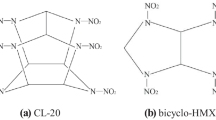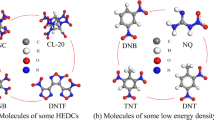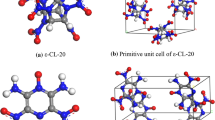Abstract
Context
Cocrystallization technology can effectively regulate crystal structure, alter packing mode, and improve physicochemical performances of energetic materials at molecule level. CL-20/HMX cocrystal explosive has high energy density than HMX, but it also exhibits high mechanical sensitivity. To decrease the sensitivity and improve the properties of CL-20/HMX energetic cocrystal, the three-component energetic cocrystal CL-20/HMX/TNAD was designed. The properties of CL-20, CL-20/HMX, and CL-20/HMX/TNAD cocrystal models were predicted. The results show that CL-20/HMX/TNAD cocrystal models have better mechanical properties than CL-20/HMX cocrystal model, implying that the mechanical properties can be effectively improved. The binding energy of CL-20/HMX/TNAD cocrystal models is higher than CL-20/HMX cocrystal model, indicating that the three-component energetic cocrystal is more stable, and the cocrystal model with the ratio 3:4:1 is predicted to be the most stable phase. CL-20/HMX/TNAD cocrystal models have higher value of trigger bond energy than pure CL-20 and CL-20/HMX cocrystal models, meaning that the three-component energetic cocrystal is more insensitive. The crystal density and detonation parameters of CL-20/HMX and CL-20/HMX/TNAD cocrystal models are lower than CL-20, illustrating that the energy density is declined. The CL-20/HMX/TNAD cocrystal has higher energy density than RDX and can be regarded as a potential high energy explosive.
Methods
This paper was performed with molecular dynamics (MD) method with the software of Materials Studio 7.0 under COMPASS force field. The MD simulation was performed under isothermal-isobaric (NPT) ensemble, the temperature and pressure was 295 K and 0.0001 GPa, respectively.







Similar content being viewed by others
Data availability
All data generated or analyzed during this study are included in this article.
Code availability
Not applicable.
References
Essel JT, Cortopassi AC, Kuo KK, Leh CG, Adair JH (2012) Formation and characterization of nano-sized RDX particles produced using the RESS-AS process. Propellants Explos Pyrotech 37:699–706
Heijden AE, Creyghton YL, Marino E, Bouma RH, Scholtes GJ, Duvalois W (2008) Energetic materials: crystallization, characterization and insensitive plastic bonded explosives. Propellants Explos Pyrotech 33:25–32
Mattos E, Moreira ED, Diniz MF, Dutra R, Silva G, Iha K (2008) Characterization of polymer-coated RDX and HMX particles. Propellants Explos Pyrotech 33:44–50
Shi XF, Wang JY, Li XD, An CW (2014) Preparation and characterization of HMX/Estane nanocomposites. Central Eur J Energ Mater 11:433–442
Lara OF, Espinosa PG (2007) Cocrystals definitions. Supramol Chem 19:553–557
Bond AD (2007) What is a co-crystal. CrystEngComm 9:833–834
Bolton O, Matzger AJ (2011) Improved stability and smart-material functionality realized in an energetic cocrystal. Angew Chem Int Ed 50:8960–8963
Yang ZW, Li HZ, Huang H, Zhou XQ, Li JS, Nie FD (2013) Preparation and performance of a HNIW/TNT cocrystal explosive. Propellants Explos Pyrotech 38:495–501
Tan YW, Yang ZW, Wang HJ, Li HZ, Nie FD, Liu YC, Yu YW (2019) High energy explosive with low sensitivity: a new energetic cocrystal based on CL-20 and 1,4-DNI. Cryst Growth Des 19:4476–4482
Tan YW, Liu YC, Wang HJ, Li HZ, Nie FD, Yang ZW (2020) Different stoichiometric ratios realized in energetic-energetic cocrystals based on CL-20 and 4,5-MDNI: a smart strategy to tune performance. Cryst Growth Des 20:3826–3833
Bennion JC, Siddiqi ZR, Matzger AJ (2017) A melt castable energetic cocrystal. Chem Commun 53:6065–6068
Landenberger KB, Bolton O, Matzger AJ (2013) Two isostructural explosive cocrystals with significantly different thermodynamic stabilities. Angew Chem Int Ed 52:6468–6471
Liu N, Duan BH, Lu XM, Zhang Q, Xu MH, Mo HC, Wang BZ (2019) Preparation of CL-20/TFAZ cocrystals under aqueous conditions: balancing high performance and low sensitivity. CrystEngComm 21:7271–7279
Yang ZW, Wang HJ, Zhang JC, Ma Y, Tan YW, Nie FD, Zhang JH, Li HZ (2020) Rapid cocrystallization by exploiting differential solubility: an efficient and scalable process toward easily fabricating energetic cocrystals. Cryst Growth Des 20:2129–2134
Anderson SR, Dubé P, Krawiec M, Salan JS, Ende DJ, Samuels P (2016) Promising CL-20-based energetic material by cocrystallization. Propellants Explos Pyrotech 41:783–788
Nielsen AT, Chafin AP, Christian SL, Moore DW, Nadler MP, Nissan RA, Vanderah DJ, Gilardi RD, George CF, Flippen-Anderson JL (1998) Synthesis of polyazapolycyclic caged polynitramines. Tetrahedron 54:11793–11812
Sikder AK, Sikder N (2004) A review of advanced high performance, insensitive and thermally stable energetic materials emerging for military and space applications. J Hazard Mater 112:1–15
Bolton O, Simke LR, Pagoria PF, Matzger AJ (2012) High power explosive with good sensitivity: a 2:1 cocrystal of CL-20:HMX. Cryst Growth Des 12:4311–4314
Gao B, Wang DJ, Zhang J, Hu YJ, Shen JP, Wang J, Huang B, Qiao ZQ, Huang H, Nie FD, Yang GC (2014) Facile, continuous and large-scale synthesis of CL-20/HMX nano co-crystals with high-performance by ultrasonic spray-assisted electrostatic adsorption method. J Mater Chem A 2:19969–19974
Qiu HW, Patel RB, Damavarapu RS, Stepanov V (2015) Nanoscale 2CL-20·HMX high explosive cocrystal synthesized by bead milling. CrystEngComm 17:4080–4083
Song CK, An CW, Zhang YR, Ye BY, Li HQ, Wang JY (2017) Insensitive CL-20/cyclotetramethylenetetramine (HMX) co-crystals with high performance by ultrasonic in solvent. Int J Energ Mater Chem Propul 16:321–328
Ghosh M, Sikder AK, Banerjee S, Gonnade RG (2018) Studies on CL-20/HMX (2:1) co-crystal: a new preparation method, structural and thermo kinetic analysis. Cryst Growth Des 18:3781–3793
Sun SH, Zhang HB, Liu Y, Xu JJ, Huang SL, Wang SM, Sun J (2018) Transitions from separately crystallized CL-20 and HMX to CL-20/HMX cocrystal based on solvent media. Cryst Growth Des 18:77–84
Willer RL (1983) Synthesis and characterization of high energy compounds. I. trans-1,4,5,8-tetranitro-1,4,5,8-tetraazadecalin (TNAD). Propellants Explos Pyrotech 8:65–69
Foltz MF, Coon CL, Garcia F, Nichols AL (1994) The thermal stability of the polymorphs of hexanitrohexaazaisowurtzitane, Part I. Propellants Explos Pyrotech 19:19–25
Agrawal JP (2005) Some new high energy materials and their formulations for specialized applications. Propellants Explos Pyrotech 30:316–328
Zhao XQ, Shi NC (1995) Crystal structure of ε-hexanitrohexaazaisowurtzitane. Chin Sci Bull 40:2158–2160
Cady HH, Larson AC, Cromer DT (1963) The crystal of α-HMX and a refinement of the structure of β-HMX. Acta Crystallogr 16:617–623
Choi CS, Boutin HP (1970) A study of the crystal structure of β-cyclotetramethylene tetranitramine by neutron diffraction. Acta Crystallogr B 26:1235–1240
Sun H, Ren PJ, Fried R (1998) The COMPASS force field: parameterization and validation for phosphazenes. Comput Theor Polym Sci 8:229–246
Bunte SW, Sun H (2000) Molecular modeling of energetic materials: the parameterization and validation of nitrate esters in the COMPASS force field. J Phys Chem B 104:2477–2489
Michael JM, Sun H, Rigby D (2004) Development and validation of COMPASS force field parameters for molecules with aliphatic azide chains. J Comput Chem 25:61–71
Andersen HC (1980) Molecular dynamics simulations at constant pressure and/or temperature. J Chem Phys 72:2384–2393
Parrinello M, Rahman A (1981) Polymorphic transitions in single crystals: a new molecular dynamics method. J Appl Phys 52:7182–7190
Allen MP, Tildesley DJ (1987) Computer simulation of liquids. Oxford University Press, Oxford
Ewald PP (1921) Evaluation of optical and electrostatic lattice potentials. Ann Phys 64:253–287
Casewit CJ, Colwell KS, Rappé AK (1992) Application of a universal force field to organic molecules. J Am Chem Soc 114:10035–10046
Rappé AK, Colwell KS, Casewit CJ (1993) Application of a Universal force field to metal complexes. Inorg Chem 32:3438–3450
Mayo SL, Olafson BD, Goddard WA III (1990) Dreiding: a generic force field for molecular simulations. J Phys Chem B 94:8897–8909
Sun H (1994) Force field for computation of conformational energies, structures, and vibrational frequencies of aromatic polyesters. J Comput Chem 15:752–768
Weiner JH (1983) Statistical mechanics of elasticity. John Wiley, New York
Wu JL (1993) Mechanics of elasticity. Tongji University Press, Shanghai
Watt JP, Davies GF, O’Connell RJ (1976) The elastic properties of composite materials. Rev Geophys Space Phys 14:541–563
Xiao JJ, Wang WR, Chen J, Ji GF, Zhu W, Xiao HM (2012) Study on the relations of sensitivity with energy properties for HMX and HMX-based PBXs by molecular dynamics simulation. Physica B 407:3504–3509
Xiao JJ, Li SY, Chen J, Ji GF, Zhu W, Zhao F, Wu Q, Xiao HM (2013) Molecular dynamics study on the correlation between structure and sensitivity for defective RDX crystals and their PBXs. J Mol Model 19:803–809
Sun T, Xiao JJ, Liu Q, Zhao F, Xiao HM (2014) Comparative study on structure, energetic and mechanical properties of a ε-CL-20/HMX cocrystal and its composite with molecular dynamics simulation. J Mater Chem A 2:13898–13904
Xiao JJ, Zhao L, Zhu W, Chen J, Ji GF, Zhao F, Wu Q, Xiao HM (2012) Molecular dynamics study on the relationships of modeling, structural and energy properties with sensitivity for RDX-based PBXs. Sci China Chem 55:2587–2594
Xu XJ, Xiao HM, Ju XH, Gong XD (2005) Theoretical study on pyrolysis mechanism for ε-hexanitrohexaazaisowurtzitane. Chin J Org Chem 25:536–539
Geetha M, Nair UR, Sarwade DB, Gore GM, Asthana SN, Singh H (2003) Studies on CL-20: the most powerful high energy material. J Therm Anal Calorim 73:913–922
Rothstein LR, Petersen R (1979) Predicting high explosive detonation velocities from their composition and structure. Propellants Explos Pyrotech 4:56–60
Rothstein LR (1981) Predicting high explosive detonation velocities from their composition and structure (II). Propellants Explos Pyrotech 6:91–93
Kamlet MJ, Ablard JE (1968) Chemistry of detonations. II. Buffered equilibria. J Chem Phys 48:36
Kamlet MJ, Dickinson D (1968) Chemistry of detonations. III. Evaluation of the simplified calculational method for Chapman-Jouguet detonation pressures on the basis of available experimental information. J Chem Phys 48:43–50
Gottfried JL, Pesce-Rodriguez RA, Farrow D, Dellinger J (2018) Laboratory-scale investigation of the influence of ageing on the performance and sensitivity of an explosive containing ε-CL-20. Propellants Explos Pyrotech 43:616–625
Muravyev NV, Wozniak DR, Piercey DG (2022) Progress and performance of energetic materials: open dataset, tool, and implications for synthesis. J Mater Chem A 10:11054–11073
Funding
This research was supported by Young Talent Fund of University Association for Science and Technology in Shaanxi, China (grant number 20200604).
Author information
Authors and Affiliations
Contributions
Gui-Yun Hang: investigation, data analysis, and writing—original draft. Tao Wang: conceptualization and methodology. Chao Lu: modeling and data analysis. Jin-Tao Wang: visualization and software. Wen-Li Yu: investigation and validation. Hui-Ming Shen: modeling and simulation.
Corresponding author
Ethics declarations
Conflict of interest
The authors declare no competing interests.
Additional information
Publisher's note
Springer Nature remains neutral with regard to jurisdictional claims in published maps and institutional affiliations.
Rights and permissions
Springer Nature or its licensor (e.g. a society or other partner) holds exclusive rights to this article under a publishing agreement with the author(s) or other rightsholder(s); author self-archiving of the accepted manuscript version of this article is solely governed by the terms of such publishing agreement and applicable law.
About this article
Cite this article
Hang, GY., Wang, T., Lu, C. et al. Designing and property prediction of a novel three-component CL-20/HMX/TNAD energetic cocrystal explosive by MD method. J Mol Model 29, 78 (2023). https://doi.org/10.1007/s00894-023-05481-z
Received:
Accepted:
Published:
DOI: https://doi.org/10.1007/s00894-023-05481-z




